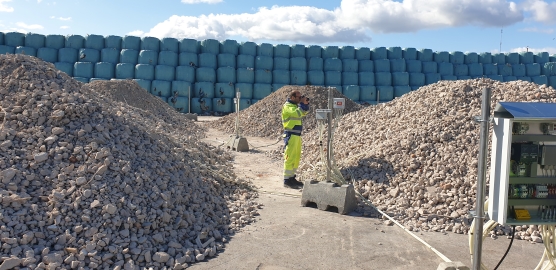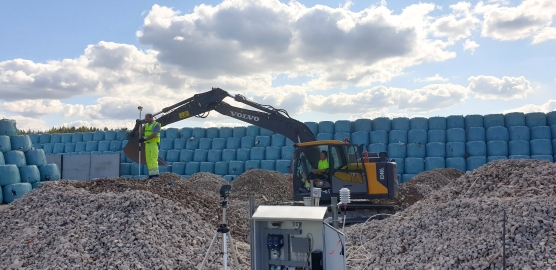The CO2ncrete Solution project investigates how concrete absorbs carbon. The investigation examines the size of the carbon stock formed by the Finnish concrete stock and the potential of the concrete recycling phase to act as a carbon sink and stock. The results will help municipalities mitigate climate change.

The CO2ncrete Solution project investigates how concrete absorbs carbon. © Image: Tommi Kekkonen.
Concrete recycling can be used to bind carbon
Cement is used as a binder in concrete, the production of which releases carbon dioxide in a chemical reaction. The reaction is called calcination, and it currently accounts for about 70% of the emissions from concrete production. However, this end product is not permanent, as carbon dioxide in the air reacts with ready-mixed concrete and binds to it permanently. This phenomenon is called carbonation.
“Based on Forecon’s detailed and thorough analysis of the concrete stock, we determined the amount of carbon stored in the concrete stock in Finland. The report also calculated the amount of concrete demolished from the building stock from which the amount of recycled concrete in Finland could then be derived,” says Tommi Kekkonen, Project Manager of the CO2ncrete Solution project at the Finnish Association of Construction Product Industries (RTT).
The report shows that approximately 5.5 million tonnes of carbon dioxide is currently bound by the concrete stock in use in Finland. The increase in the stock, or carbon sink, is approximately 100,000 tonnes of carbon dioxide per year, which corresponds to approximately 10% of the annual emissions of the Finnish cement industry.
“We also carried out a similar analysis for the ten largest Hinku municipalities, so that the values could be placed in a regional context,” says Kekkonen. “Depending on the size of the city, the annual carbon sink of the municipalities' existing concrete stocks is about 1,000–4,000 tonnes of carbon dioxide. The carbon sequestration potential of the concrete to be demolished is roughly the same, which means that significant amounts of carbon could be bound by optimised recycling methods.”

Approximately 5.5 million tonnes of carbon dioxide is currently bound by the concrete stock in use in Finland. © Photo: Concrete Industry Ltd.
The carbon sequestration potential of concrete is examined in Topinpuisto
Buildings are demolished when they reach the end of their service life. When the concrete is crushed in the demolition phase, a large area of uncarbonated surface with which carbon dioxide can react is revealed. More than 1.5 million cubic metres of concrete is demolished each year, resulting in a carbon sequestration potential of approximately 165,000 tonnes of carbon dioxide.
Recycled concrete has a great potential for carbon sequestration, but the topic has been studied very little. Research is important because the maximum amount of carbon may not necessarily be bound by crushing and using or storing concrete alone. The concrete surface must be in contact with the carbon dioxide in the air to allow carbonation to take place.
In order to promote research on the carbon sequestration potential of recycled concrete, a research environment has been set up at the Topinpuisto Recycling Centre in cooperation with South-West Finland's Waste Management and Ekopartnerit. In the area, the carbon dioxide content, temperature and humidity are measured at different depths from four different piles of crushed concrete.

Recycled concrete has a great potential for carbon sequestration, but the topic has been studied very little. © Image: Tommi Kekkonen.
The conditions of carbonation are influenced by protecting the piles from direct rain and by sifting off small fragments from the piles in order to improve air circulation. The measurement is continued throughout the year, after which the carbon content of known concrete samples is measured at all measurement depths from the piles. Condition monitoring provides information on carbonation in different piles of crushed concrete. In the future, this information will be used for modelling different applications.
“Topinoja will produce the first results already this year. Then we will discuss with municipalities how recycled concrete could be used in different applications so that it can use its carbon sequestration potential as well as possible,” says Kekkonen. “We also aim to find new pilot sites where carbon sequestration could be optimised and measured in practice.”
Further information
- CEO Jussi Mattila, Concrete Industry Ltd, tel. +358 400 637 224, firstname.lastname@rakennusteollisuus.fi
- Product Group Manager Tiina Kaskiaro, Finnish Association of Construction Product Industries, tel. +358 50 466 0297, firstname.lastname@rakennusteollisuus.fi
- Project Manager Tommi Kekkonen, tel. +358 50 350 8820, firstname.lastname@rakennusteollisuus.fi